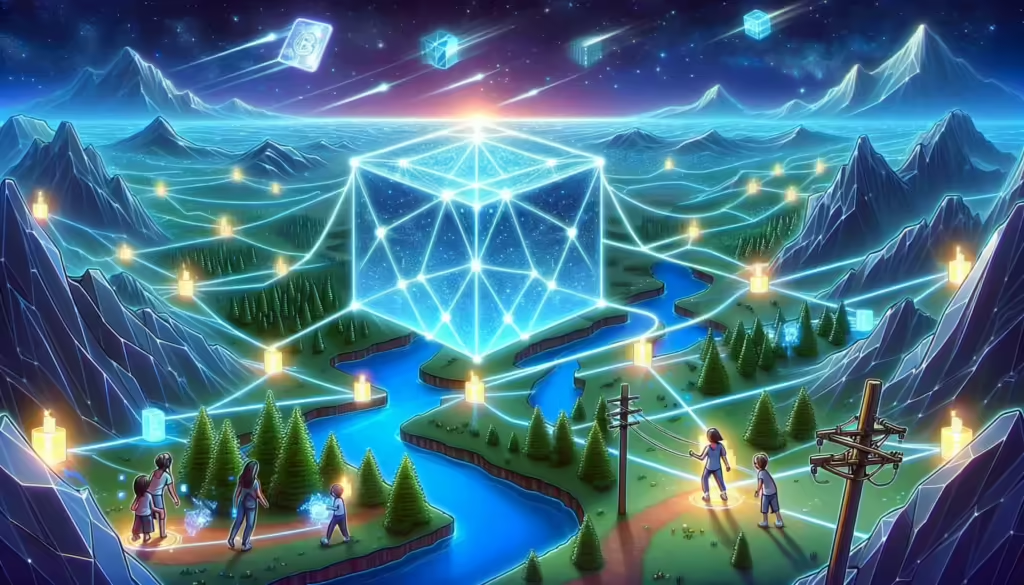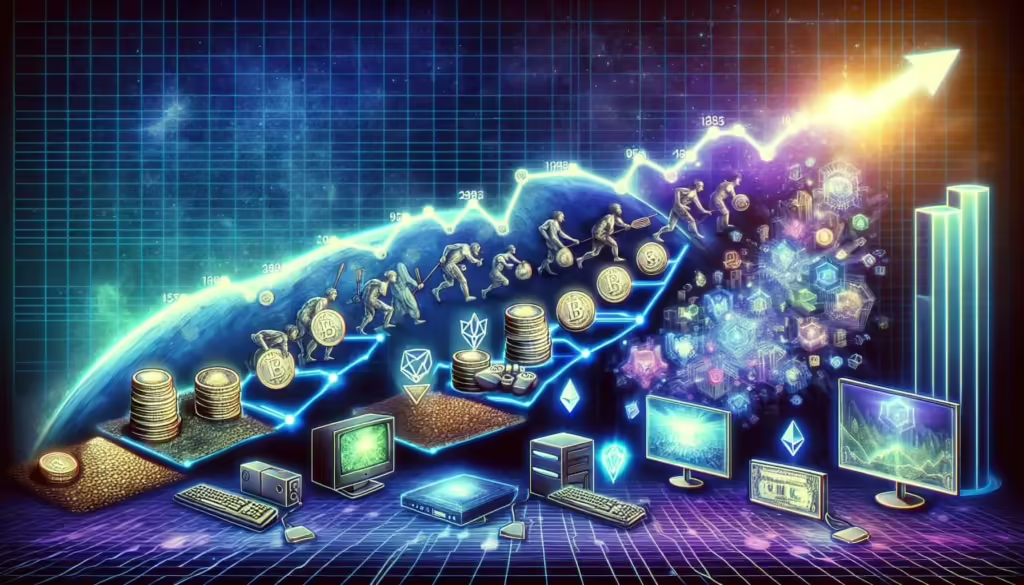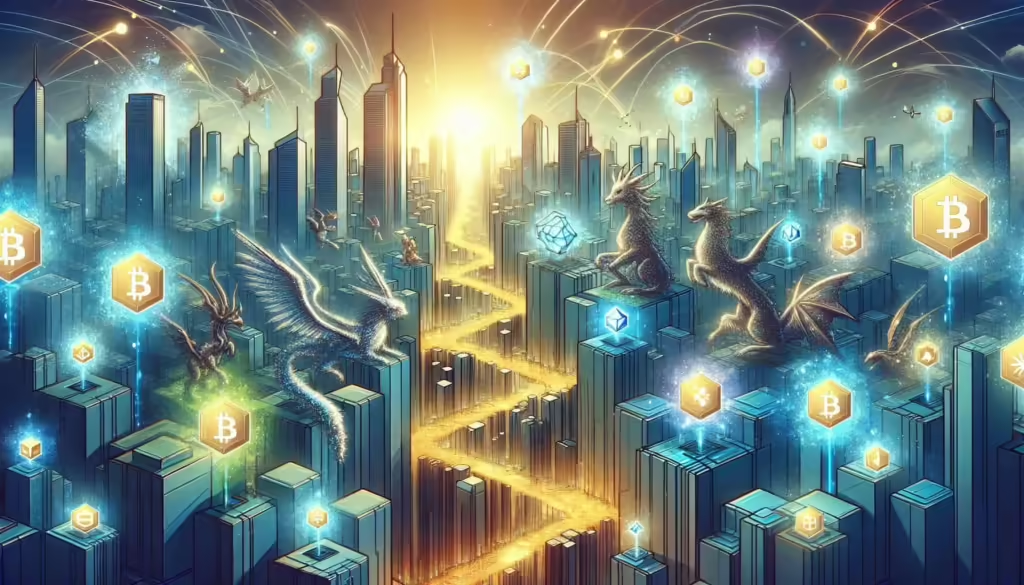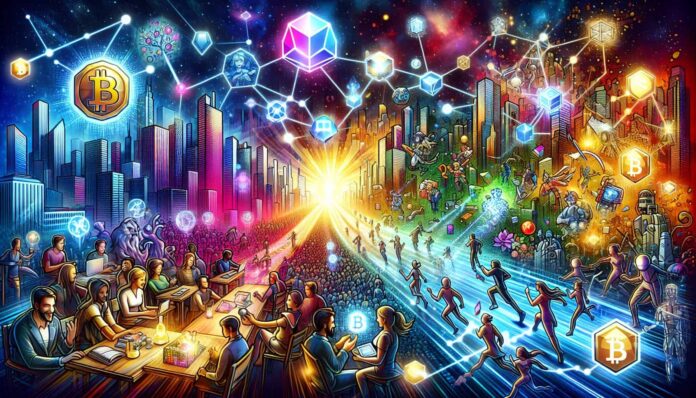What does blockchain mean for the future of gaming or we can call it web3 gaming? It promises a revolution, offering players genuine asset ownership and a chance to earn from their skills. This article strips away the hype to explore how blockchain for gaming is creating a world where gaming assets are no longer ephemeral, play has economic value, and the rules of digital ownership are rewritten. As we uncover the ecosystem’s expansion and its hurdles, you’ll see why gamers and developers alike are taking notice.
Key Takeaways
Web3 gaming fosters transparent, player-centric economies, enabling real ownership of in-game assets and play-to-earn models, significantly transforming traditional gaming dynamics.
Blockchain-powered game economies are experiencing rapid growth with a market expected to exceed $8800 million by 2028, signifying a major shift from traditional gaming models to token-based incentives and ownership.
AdvertisementDespite challenges such as technical barriers and the need for improved user experience, advancements like appchains and increased major game company investments are driving innovation in blockchain gaming.
Unlocking the Potential of Blockchain in Video Games (Web3 Gaming)

The application of blockchain technology in video games is revolutionizing the gaming industry. Blockchain games integrate various blockchain technologies such as NFTs, utility tokens, and decentralized autonomous organizations (DAOs) to create a robust gaming framework. This secure and transparent framework for transactions ensures the integrity of in-game asset ownership, fostering player trust.
The overarching goal of incorporating blockchain in games is to cultivate a more transparent relationship between players and game developers. Blockchain gaming upends the conventions of traditional gaming economies by leveraging a transparent and secure infrastructure for managing in-game assets. This shift empowers player ownership and contributions, making gaming more than just a pastime—it becomes a potentially profitable venture.
The Mechanics of Play-to-Earn Models
Play-to-earn models have emerged as a revolutionary concept in the world of blockchain games. These models operate by allowing players to earn cryptocurrencies and tokenize in-game assets as they engage in various in-game activities like battles, exploration, crafting, and trading. The integration of smart contracts in these games automates key in-game functions such as the creation, movement, and trading of in-game items, providing a reliable and secure mechanism for players to interact with the game’s economy.
The play-to-earn model flips the script on traditional gaming. Rather than spending money to enhance their gaming experience, players can now earn real money by playing blockchain games. This shift is paving the way for an entirely new economic model where gaming can evolve into a full-time profession.
Tokenization of In-Game Items
Tokenization of in-game items is another transformative aspect of blockchain games. Through the implementation of NFTs, blockchain gaming establishes verifiable ownership, allowing players to have true digital ownership of in-game assets. This means players can truly own their in-game items, characters, and cards, each represented as unique, transferable assets within the digital ecosystem of NFT games.
This transformation extends the gaming experience beyond the confines of the game, including traditional games and traditional video games. Players can:
Trade and monetize their in-game assets and in game currency on secondary markets due to blockchain integration
Enhance the traditional concepts of user-generated content and intellectual property ownership
Reap the rewards of their time and effort
This allows players to fully benefit from their gaming experience as they play games.
Decentralizing Gaming Power
Decentralization is a defining characteristic of blockchain games. These decentralized applications empower players and facilitate community governance, giving players more influence in game development. This player-centric approach is a significant departure from traditional gaming models where power is concentrated in the hands of game publishers and developers.
Decentralized Autonomous Organizations (DAOs) in blockchain games allow for a player-owned governance structure, where tokens coordinate activities and give players membership and governance rights. The shift towards decentralized play-to-earn models has diminished the control of central gaming authorities, granting players greater power over their in-game assets and the financial aspects of gaming. This area of game governance through tokens is still largely unexplored, offering vast opportunities for innovative approaches to player involvement and decision-making.
The Evolution of Game Economies with Blockchain

The integration of blockchain technology has led to a significant evolution in game economies in web3 gmaing. The market for blockchain-based game economies is thriving, recording a substantial market size. In 2022, the market size of Play-to-Earn (P2E) games within this sector was $3292.73 million.
This growth trend shows no signs of slowing down. On the contrary, this thriving market is projected to grow even further, with estimations predicting it to exceed $8800 million by the year 2028.
These numbers reflect the transformative impact of blockchain technology on the gaming industry and the immense potential it holds for the future of gaming.
From Traditional to Token: Economic Shifts in Web3 Gaming
The economic landscape of gaming is shifting from traditional to token-based models, driven by the integration of blockchain technology. Blockchain allows for greater control over in-game assets, providing transparency and the potential for players to profit from trading. This shift to blockchain-based systems leads to more open and fair in-game economies, where tokenomics define the minting, distribution, and pricing of assets.
In addition, the standardization of in-game assets through appchains enhances their value and utility across different games on the same chain. New valuation approaches are being developed for blockchain games, taking into account community ownership, token-based incentives, and user-generated content. This represents a paradigm shift from traditional gaming economies, paving the way for innovative economic models in gaming.
Case Studies of Successful Crypto Games and Web3 Gaming

Blockchain gaming has seen a flurry of success stories, with crypto gaming experiences like Axie Infinity leading the way. Axie Infinity serves as a prime case study of successful play-to-earn games, allowing players to earn cryptocurrency and establish genuine ownership over their in-game assets. The developer of Axie Infinity, Sky Mavis Pte. Ltd., plays a pivotal role in advancing the blockchain gaming market.
The sustainable economic model implemented by Axie Infinity has played a crucial role in maintaining a vibrant and active virtual world. The success of such games not only validates the potential of blockchain gaming but also provides a roadmap for future game developers to follow.
Overcoming Challenges in Blockchain Gaming
While blockchain gaming holds immense potential, it’s not without its challenges. Blockchain games today face significant technical hurdles, such as computational and latency requirements that current blockchain infrastructures struggle to support. Additionally, new players to blockchain gaming often face a steep learning curve due to complexities like setting up third-party wallets, acquiring network tokens, and managing transaction signatures.
However, these challenges are not insurmountable. Innovative solutions are emerging that promise to address these technical barriers, leading to a more robust infrastructure for future games. While interoperability and connectivity remain a challenge, with players facing fragmented ecosystems across different layer-1 and layer-2 blockchain environments, advancements in blockchain technology are set to overcome these limitations.
Enhancing User Experience in Blockchain Games

One of the key challenges in blockchain gaming is enhancing the user experience. Advancements in blockchain scalability, such as the implementation of gaming appchains, are enhancing player experience by ensuring immediate in-game actions like item trading and score updating. Layer-2 environments in Web3 games alleviate computational barriers, leading to reduced network congestion and lower transaction fees for players.
Moreover, wallet account abstraction in blockchain gaming is simplifying player interactions by removing frequent transaction confirmations and in some cases, eliminating fees altogether. These developments are making blockchain games more accessible and user-friendly, contributing to the growing popularity of this gaming paradigm.
Building Cross-Chain Connectivity
Building cross-chain connectivity is another crucial aspect of enhancing the user experience in blockchain gaming. Appchains enable cross-game asset interoperability, allowing players to:
Use certain assets across different games within the same chain
Increase liquidity of gaming assets
Facilitate their use and exchange across different game titles
Enhance the value of in-game assets
Furthermore, appchains create opportunities for collaborations between different games and brands, potentially transforming how digital assets are utilized and valued. This cross-chain connectivity adds a new dimension to the gaming experience, unlocking the potential for a more integrated and immersive virtual gaming world.
Advancements and Innovations in Blockchain Gaming
The world of blockchain gaming is witnessing significant advancements and innovations. Developers are leveraging application-specific chains, or appchains, to address the performance needs of blockchain games, such as higher transaction speeds and throughput. By fine-tuning blockchain parameters through these appchains, developers can create a controlled gaming environment, thereby improving the gaming experience.
Furthermore, the evolution of the underlying blockchain networks is influencing the design and usability of blockchain games. The integration of cutting-edge technologies such as virtual reality, artificial intelligence, and augmented reality with blockchain has elevated the gaming experience to new levels of engagement. These advancements are paving the way for more sophisticated and immersive blockchain gaming titles, enhancing player engagement.
Investment and Interest from Major Game Companies
The advancements and potential of blockchain gaming have caught the attention of major game companies, leading to increased investment and interest in this sector. Significant investments in blockchain gaming in 2023, totaling $2.3 billion, reflect investor confidence in the sector’s growth. For instance, Animoca Brands, a gaming company, raised over $565 million in 2022, highlighting the strong investment interest in blockchain gaming platforms.
This surge of interest and investment from major game companies signifies a crucial turning point in the gaming industry. It not only validates the potential of blockchain gaming but also sets the stage for its integration into mainstream gaming, paving the way for a new era of gaming.
New Frontiers in Game Design and Player Engagement
Blockchain technology is enabling new frontiers in game design and player engagement. Empowered by blockchain, participants in the gaming industry partake in the process of development and innovation while monetizing their crypto assets, bolstering player engagement and empowerment. The use of specifically designed appchains for game development simplifies the creation of custom APIs and components, which encourages innovation and creativity in game design.
Moreover, blockchain technology has been instrumental in enabling the creation of a diverse range of gaming environments, from intricate strategy games to expansive virtual worlds. The integration of blockchain technology with virtual reality, artificial intelligence, and augmented reality has given rise to immersive gaming experiences, marking a new frontier in game design and player engagement.
Hedera’s Pioneering Role in Blockchain Gaming
In the realm of blockchain gaming, Hedera plays a pioneering role. With major gaming companies like Ubisoft and Electronic Arts in its governance, Hedera showcases its strong connections and influence within the gaming industry. Recognized for its rapid and secure transaction capabilities, Hedera Hashgraph is a sought-after platform among blockchain game developers.
Its ability to efficiently process high volumes of transactions is key to the functionality of play-to-earn gaming models. Notably, Hedera’s capability to handle high-transaction scenarios efficiently not only supports play-to-earn models but also aids in mitigating cheating, thus maintaining game integrity. Hence, Hedera continues to play a pivotal role in shaping the future of blockchain gaming.
Summary
Blockchain gaming is not merely a buzzword—it’s a groundbreaking development that is transforming the gaming industry. From enabling play-to-earn models, tokenizing in-game assets, and decentralizing gaming power to fostering a new economic model in gaming, blockchain technology is paving the way for a revolution in the way we play and engage with games.
The potential of blockchain gaming is immense, and although it faces challenges, emerging solutions are addressing these limitations, leading to a more robust infrastructure for future games. With major game companies showing increased interest and investment, it’s clear that blockchain gaming is here to stay. As we move forward, the lines between gaming and reality will continue to blur, opening up new frontiers of innovation, engagement, and opportunities.
Frequently Asked Questions
What is the market size of P2E games in 2022?
The market size of P2E games in 2022 was $3292.73 million, indicating a significant growth in the industry.
What is the projected market size of P2E games by 2028?
The projected market size of P2E games by 2028 is more than $8800 million.
How do play-to-earn games work?
In play-to-earn games, players can earn cryptocurrencies as they play by leveraging blockchain technology to tokenize in-game assets, creating a self-sustaining economic ecosystem within the game.
What is the significance of decentralization in play-to-earn games?
Decentralization in play-to-earn games reduces control by central authorities and gives players more control over in-game assets and earnings. This empowers players and increases transparency and fairness in the gaming economy.
What are the common types of play-to-earn crypto games?
Play-to-earn crypto games come in various types such as RPGs, strategy games, CCGs, virtual real estate games, NFT games, battle royale, PvP games, idle games, DeFi games, sports and racing games, adventure games, and social virtual world games.
Table of Contents
Disclaimer: The information contained in this article is for informational purposes only. It should not be considered as financial or investment advice. The reader should do their own research before making any financial decisions based on the information provided above. Hash Herald is not responsible for any losses in market













